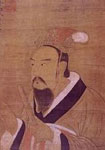“可無人與畫將歸”的意思及全詩出處和翻譯賞析
“可無人與畫將歸”全詩
一枝低帶流鶯睡,數片狂和舞蝶飛。
堪恨路長移不得,可無人與畫將歸。
手中已有新春桂,多謝煙香更入衣。
分類:
作者簡介(鄭谷)

鄭谷(約851~910)唐朝末期著名詩人。字守愚,漢族,江西宜春市袁州區人。僖宗時進士,官都官郎中,人稱鄭都官。又以《鷓鴣詩》得名,人稱鄭鷓鴣。其詩多寫景詠物之作,表現士大夫的閑情逸致。風格清新通俗,但流于淺率。曾與許裳、張喬等唱和往還,號“芳林十哲”。原有集,已散佚,存《云臺編》。
《擢第后入蜀經羅村,路見海棠盛開偶有題詠》鄭谷 翻譯、賞析和詩意
擢第后入蜀經羅村,
After being promoted, I entered the Shu region and passed through the village of Luo.
路見海棠盛開偶有題詠。
On the way, I saw the sea of blooming cherry blossoms and occasionally some poems written about it.
上國休夸紅杏艷,
The capital should not boast about the beauty of apricot blossoms,
深溪自照綠苔磯。
For in this deep valley, the green moss on the rocks reflects its own beauty.
一枝低帶流鶯睡,
A branch hangs low, carrying a sleeping warbler,
數片狂和舞蝶飛。
While a few pieces of fallen petals dance in the air like crazy butterflies.
堪恨路長移不得,
I regret that I can't stay longer as I continue my journey,
可無人與畫將歸。
And no one is there to bring back a painting of this scene.
手中已有新春桂,
But I already have a branch of a new year's cassia in my hand,
多謝煙香更入衣。
Which I am grateful for as its fragrance seeps into my clothes.
這首詩描述了作者擢第(考中進士)后游歷蜀地(四川地區)經過羅村時的情景。詩中描繪了羅村的美麗景色,特別是盛開的海棠花景。作者以簡潔而優美的語言,展示了大自然的美麗和悠閑的田園生活。詩中還暗示了作者對長途旅行的不滿和渴望停下來欣賞和繪畫這美景。最后,作者提到了他手中拿著的新春桂枝和穿衣服沾染了桂花的香氣,表達了他對春天和美好生活的渴望和感激之情。整首詩以自然景色為背景,表達了詩人對美好生活和自然之美的向往和贊美。
“可無人與畫將歸”全詩拼音讀音對照參考
zhuó dì hòu rù shǔ jīng luó cūn, lù jiàn hǎi táng shèng kāi ǒu yǒu tí yǒng
擢第后入蜀經羅村,路見海棠盛開偶有題詠
shàng guó xiū kuā hóng xìng yàn, shēn xī zì zhào lǜ tái jī.
上國休夸紅杏艷,深溪自照綠苔磯。
yī zhī dī dài liú yīng shuì,
一枝低帶流鶯睡,
shù piàn kuáng hé wǔ dié fēi.
數片狂和舞蝶飛。
kān hèn lù cháng yí bù dé, kě wú rén yǔ huà jiāng guī.
堪恨路長移不得,可無人與畫將歸。
shǒu zhōng yǐ yǒu xīn chūn guì, duō xiè yān xiāng gèng rù yī.
手中已有新春桂,多謝煙香更入衣。
“可無人與畫將歸”平仄韻腳
平仄:仄平平仄仄平平
韻腳:(平韻) 上平五微 * 平仄拼音來自網絡,僅供參考;詩句韻腳有多個的時候,對比全詩即可判斷。